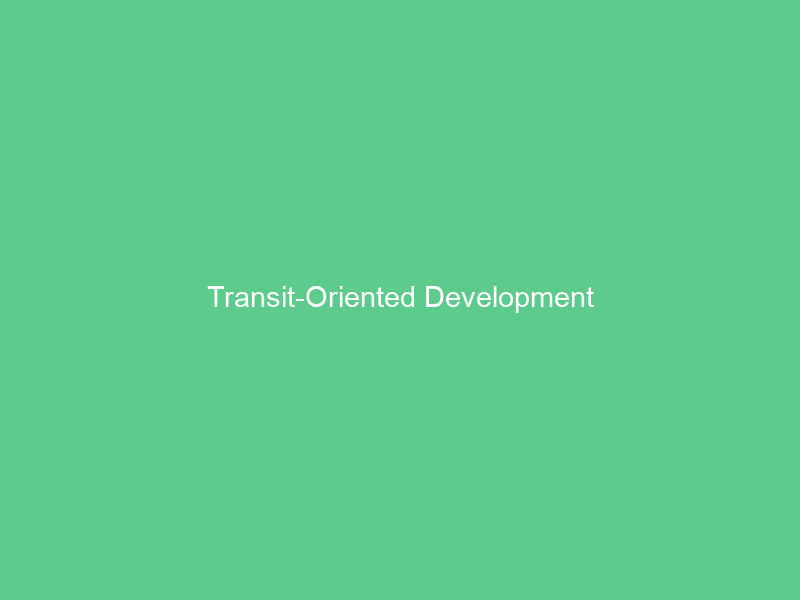Communities situated around high-quality public transit offer residents more and better amenities, vibrant centers of activity, shorter commuting distances and increased market value. TOD principles can be implemented both in large cities with extensive networks as well as villages with only a single rail or bus line.
TOD (Transit-Oriented Development) is an urban design strategy that centers jobs, housing and community spaces around transit stations within walking distance, creating compact developments with higher densities.
Walkable Communities
Walkable communities give residents an opportunity to incorporate walking into daily life, which reduces car dependence, decreases air pollution levels, promotes public health and community wellbeing while supporting social inclusion.
Effective zoning policies in walkable neighborhoods aim to integrate housing, workplaces, retail spaces, recreational amenities and transit stations in an area into compact districts that are easily walkable from one another. This maximizes public transit capacities while creating an environment capable of meeting most daily needs without private vehicles being necessary.
Walkable neighborhoods often include small businesses that keep tax money within their community and create employment for local residents, and the increased pedestrian traffic can help create safer streets as well as lower crime rates. Furthermore, green space and public parks provide residents with opportunities for recreation and relaxation; reduced vehicle traffic contributes to lower noise pollution levels.
High-Quality Public Spaces
TODs focus on creating safe, inclusive public spaces that promote community interaction and an active lifestyle for their residents. High-quality public spaces are a cornerstone of TODs, and can be realized in various ways.
TOD sites typically comprise mixed land uses of housing and commercial within half a mile walking distance from a transit station, providing people with everything they need without using their vehicles (APTA 2009). Such mixed use communities create vibrant street life while reaping economic agglomeration benefits by having jobs close to where people reside (APTA 2009).
Public space provision can be an enormously challenging undertaking in any city, yet even modest investments combined with meaningful programming and citizen involvement can have significant positive outcomes. PPS offers a new tool called Public Space Site-specific Assessment that can assist cities in evaluating their existing public spaces and making improvements that are focused on safety, inclusion, connectivity and accessibility. The Public Space Site-specific Assessment is divided into four phases and contains 20 indicators related to safety, inclusion, connectivity and accessibility.
Economic Vitality
Economic vitality refers to the ability to attract, retain and expand jobs and businesses sustainably. Transit-oriented development techniques offer one way of accomplishing this by clustering land uses and commercial activities around public transportation stations.
TOD strategies have proven successful globally in cities like Hong Kong, Copenhagen and Portland. Studies demonstrate how TOD increases property values and business growth while simultaneously decreasing car dependence and encouraging sustainable economic development.
TOD strategies can be utilized to increase access to quality jobs, schools and services that make communities more livable for all. When used alongside equitable processes, TOD allows community members to participate in shaping decisions that shape local economies.
For instance, in Babylon the Town partnered with developers and MTA agencies to establish walkable neighborhoods near LIRR’s Wyandanch Station. These TOD neighborhoods feature various housing options, retail services and parks while simultaneously supporting affordable housing solutions with strong tenant protection policies. For equitable outcomes to be realized by residents at all stages of planning decisions is vitally important.
Healthier Communities
Healthier communities are vital for residents, businesses, and visitors. TOD techniques can help foster healthier lifestyles by making it easy for people to walk or ride bikes to access food, recreation, jobs – thus reducing dependence on cars and fossil fuels.
TOD can promote healthier living by offering amenities, like farmers’ markets, community gardens and fitness centers located close to transit stops. Increased foot traffic within TOD neighborhoods also enables small local businesses to thrive – reinvested into the community via taxes paid into TOD neighborhoods.
Establishing equitable TOD requires careful consideration of local conditions and concerns. For instance, high demand for housing near transit stations can drive up prices and rents, potentially displacing low-income people from affordable accommodation. To mitigate this risk, community-based organizations and local residents must be integrated from the start into TOD planning processes alongside developers, transit agencies, and funders – please see resources on the right for more information about how you can advance equity in TODs.

